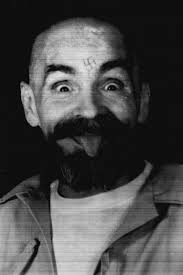To Preface: I am not by any means an expert on the Manson Family, just an interested college student. The following post is an opinion based on facts, but please do not mistake my opinion for fact.
Charles Mason
Criminals Minds episode “The Tribe” has been said to mirror the events of the Manson Family—a pack of murderers led by passionate leader Charles Manson. Born in Cincinnati, Ohio to an irresponsible 16 year old, Manson’s childhood was far from ideal. His mother didn’t have the means or the desire to care for him, so he had to constantly move between the homes of his extended family. In one account, Manson’s mother actually sold Charles in a café for a pitcher of beer…I don’t think she was receiving any mother of the year awards. Manson remained missing for days before his uncle found him to bring him home. Manson’s unstable and unsafe childhood fostered a burning desire to receive attention and feel love—he achieved that through the devotion of his followers and their willingness to kill.
Charles Mason and Jackson Cally
In order to determine how accurately “The Tribe” portrays the events of the Manson Family, I watched the episode a good 6 or 7 times. Each time, I became more and more impressed by how closely the writers stuck to Manson’s actual life. Like Manson, the leader of the cult in “The Tribe” (Jackson Cally, portrayed by Chad Allen) never really had a home—he spent his childhood moving in and out of foster care. Cally was also cunning, manipulative, and refrained from participating in all of his cult’s crimes—just like Manson. In the episode, Morgan actually uses Manson as a comparison: “Like Manson, Cally has been forced to become an expert profiler of sorts. He reads the people around him.” These people that Manson and Cally “read” are not the victims; they read their followers. Cult leaders like Manson and Cally profile people around them to determine whom they can push, and how far they can push them.
Race Wars
Despite the eerie similarities, the most well executed parallel between the episode and real world events was not the personality characteristics of Cally and Manson, it was the leaders’ motives: both Cally and Manson wanted to start a race war. In 1968, right after the Beatles came out with their White album, Manson determined that a race war would occur, and he called it Helter Skelter (one of the song titles on the Beatle album). He believed that black men would retaliate against whites—killing every white person in their paths until white people ceased to exist. Manson predicted Helter Skleter would occur in the summer of 1969 and when it didn’t, he decided to do something to initiate it: “The only thing that blackie knows is what white has told him” he explained to his followers before ordering them to murder four adults in Beverly Hills, “I’m going to have to show him how to do it.” Manson “knew” a war was coming—so he decided to initiate it.
“The Tribe” follows a very similar sequence of events. When the BAU apprehends Cally’s cult, they do so in a schoolhouse where his followers were planning to kill a classroom of Native American students in the Apache reservation. Cally ordered his devotees to do this because like Mason, he wanted to start a war. Only instead of a Helter Skelter between all the black and white people in the world, Cally wanted to initiate a war between the Apache Indians and the all white ADU (American Defense unit).
The Difference
There was one component of this episode that I found especially interesting: white Cally and his all white followers were fighting for the minority. Cally’s cult wants to trigger this war so the Apache fights the ADU for their people and their land. Manson, on the other hand, fought for the people like him—the white people. I don’t have any epiphanic thoughts as to why the writers of Criminal Minds chose to execute the show in this fashion, probably just creative expression, but I thought it was a discrepancy worth noting.
With all things considered, writers Jeff Daivs and Andrew Wilder and director Matt Earl Beesley did an excellent job creating a fictional representation of a very real story.

